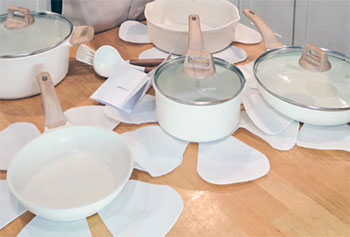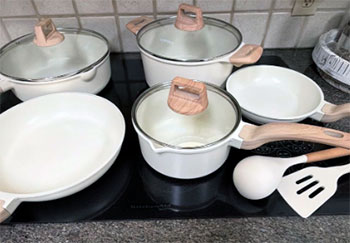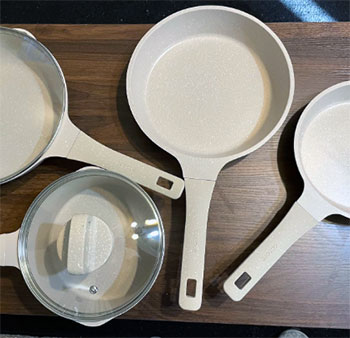If you are looking for cookware that blends aesthetic appeal with functional non-stick performance, you should buy Carote pots and pans directly from their official website or Amazon official store to ensure warranty coverage. These channels often have the best bundle deals and authentic stock.
My Experience With Carote Pots and Pans
I remember scrolling through social media and constantly seeing these beautiful, creamy white pans with rustic wood-patterned handles. My current cookware situation was dire—a mismatched collection of scratched Teflon and warped aluminum that made frying an egg feel like a high-stakes gamble. I finally caved and bought the 10-piece Carote Granite Cookware set. I wanted to see if they were just “internet pretty” or if they could actually handle my chaotic Tuesday night dinners.

When the box arrived, the first thing I noticed was the weight. Or rather, the lack of it.
Compared to my heavy cast iron skillet, the Carote frying pan felt incredibly light in my hand.
At first, I was worried this meant they were cheap or flimsy, but the die-cast aluminum construction felt solid, just manageable.
The “wood” handle is actually Bakelite—a heat-resistant plastic—but it has a soft-touch finish that feels surprisingly grippy and comfortable. It doesn’t get hot, which is a massive plus when I’m juggling three burners.
My first test was the classic fried egg, the nemesis of sticky pans. I added a tiny drop of oil, mostly out of habit, and cracked the egg in. It skated across the surface like it was on an ice rink. I didn’t even need a spatula to flip it; a gentle wrist flick sent the egg airborne and back down without a single bit of residue sticking to the bottom. It was genuinely satisfying. Over the next few weeks, I pushed them harder. I made sticky teriyaki chicken, cheesy pasta sauces, and even seared a few steaks.
The cleanup process was the biggest shock. With my old pans, I’d have to soak and scrub. With the Carote granite pan, a simple rinse with warm water and a wipe with a soft sponge took everything off. The white interior, which I feared would stain immediately with tomato sauce or turmeric, actually wiped clean easily, provided I didn’t leave it sitting for days.
However, the experience wasn’t entirely perfect. I learned the hard way that these pans really cannot handle high heat. One evening, I got impatient boiling water for pasta and cranked the gas burner to the max. The flame licked up the side of the pot, and I immediately smelled burning plastic. The “wood” handle near the connection point had scorched slightly. It was a cosmetic issue, but it taught me that “medium heat” isn’t just a suggestion for these pans; it is a rule.
Another thing I noticed after about six months of daily use is that the exterior bottom—the part that touches the stove grate—does get discolored. It turns a bit brownish if you have a gas stove, likely from oil drips getting baked on. It doesn’t affect the cooking, but that pristine Instagram look doesn’t last forever unless you are obsessively careful. Despite these minor hiccups, my time with Carote has been largely positive. They make cooking feel less like a chore because I know I won’t be fighting with the pan to get my food out or scrubbing for twenty minutes afterward.
Read More: My Thoughts On Bobby Flay Cookware
Pros Of Carote Cookware
- Exceptional Non-Stick Performance: The most immediate benefit I noticed was the slick surface. This “granite” coating is actually a multi-layer ceramic reinforced material that releases food effortlessly. You can cook healthy meals with virtually zero oil or butter if you choose. I have cooked delicate fish fillets and pancakes that usually tear apart in lesser pans, and they slid right out of the Carote pan intact. It reduces the stress of cooking significantly because you aren’t constantly scraping food off the bottom.
- Lightweight and Maneuverable: If you struggle with heavy cookware like cast iron or multi-ply stainless steel, these pans are a relief. The die-cast aluminum body is thick enough to conduct heat well but light enough that you can easily lift a full pot of soup or flip a stir-fry with one hand. This makes them accessible for elderly cooks or anyone with wrist issues who still wants a sturdy-feeling pan.
- Aesthetic and Modern Design: Let’s be honest, looks matter. The creamy white stone look with the faux-wood handles is gorgeous. It brightens up the kitchen and looks good enough to serve directly on the table. Unlike industrial-looking stainless steel or boring black non-stick, these pans add a touch of warmth and style to your stovetop. They are designed to be displayed rather than hidden away in a cabinet.
- Quick and Even Heating: Aluminum is an excellent conductor of heat. I found that these pans heat up very quickly, which saves time and energy. Because the core is die-cast, the heat distribution is relatively even across the surface. You don’t get those intense hot spots where one part of your omelet burns while the other is still runny, provided you keep the heat setting reasonable.
- Easy Maintenance and Cleaning: The “rivetless” design on the interior is a subtle but huge pro. Most pans have metal rivets attaching the handle where food and grease get stuck and turn into brown gunk over time. Carote pans are smooth on the inside, meaning there are no crevices for bacteria or food build-up. A quick wipe with a soapy sponge is usually all it takes to get them looking brand new again.
- Affordable Price Point: Compared to high-end brands like Le Creuset or HexClad, Carote is incredibly budget-friendly. You can often get an entire set for the price of one premium skillet. For students, first-time apartment renters, or anyone on a budget, the value proposition is hard to beat. You get a lot of functionality and style for a relatively low investment.
Cons Of Carote Cookware

- Not Built for High Heat: This is the Achilles’ heel of Carote cookware. The ceramic-granite coating can degrade rapidly if exposed to high temperatures (above 400°F or high stove settings). High heat can cause the non-stick properties to vanish and can even lead to blistering of the coating. If you are someone who loves to sear steaks at ripping hot temperatures or stir-fry with a wok-hei effect, these pans will disappoint you and likely be ruined quickly.
- Handle Durability Issues: While the handles look like wood, they are made of Bakelite (plastic) and can be susceptible to heat damage. If you use a gas stove and the flame extends beyond the base of the pan, it can melt or scorch the handle near the connection point. Additionally, because they are screwed on, they can loosen over time. I had to tighten the screw on my frying pan handle after a few months of use. It’s a minor annoyance, but it speaks to the construction quality compared to riveted metal handles.
- Exterior Discoloration: The beautiful light color of the exterior is a double-edged sword. While it looks great out of the box, it shows burns, grease stains, and carbon buildup much more than a black or dark grey pan would. Once oil drips down the side and gets baked on by the heat of the stove, it is extremely difficult to remove without scrubbing, which can then damage the exterior paint. Keeping them looking “social media ready” requires a level of cleaning diligence that most people don’t have time for.
- Not Metal Utensil Safe: Despite some marketing claims you might see about “granite-like durability,” you absolutely cannot use metal whisks, spatulas, or forks in these pans. The coating is softer than traditional Teflon or hard-anodized surfaces. One slip with a metal fork can leave a deep scratch that ruins the aesthetic and compromises the non-stick function. You are strictly limited to silicone or wood tools.
- Longevity Concerns: Ceramic-based non-stick pans simply do not last as long as PTFE (Teflon) or cast iron. The non-stick naturally wears away with use. Realistically, you are looking at a lifespan of 1 to 2 years with daily use before the food starts sticking. Unlike stainless steel which lasts a lifetime, these are consumable items that will eventually need to be replaced.
- Thin Walls Prone to Warping: While the base is generally reinforced, the walls of the pans are somewhat thin to keep the weight down. If you take a hot pan and immediately run it under cold water (thermal shock), there is a significant risk of warping. Once a pan warps, it won’t sit flat on glass-top stoves, leading to uneven cooking and spinning pans.
Maintenance Tips For Carote Cookware

- Season Before First Use: Although not strictly required for all non-stick, I highly recommend “seasoning” the pan when you first get it. Wash it with warm soapy water, dry it, then rub a small amount of high-smoke-point oil (like grape seed or avocado oil) onto the surface with a paper towel. Heat it on low for a minute or two, let it cool, and wipe away the excess. This conditions the ceramic pores and enhances the non-stick release right from the start.
- Strictly Hand Wash Only: I know the packaging might say “dishwasher safe” or imply it, but do not put these pans in the dishwasher. The harsh detergents and high-pressure hot water sprays will erode the coating and dull the exterior finish very quickly. The dishwasher detergent can be abrasive and cause the non-stick layer to dry out and fail prematurely. Hand washing takes thirty seconds because nothing sticks to them anyway.
- Use Low to Medium Heat: This is the golden rule. Never turn your burner knob past the halfway point. Aluminum conducts heat so efficiently that medium heat on a Carote pan is equivalent to high heat on a stainless steel pan. Cooking on low or medium is sufficient for searing, boiling, and frying. Excessive heat is the number one reason these pans fail, leading to sticking food and burnt exteriors.
- Avoid Thermal Shock: Never take a piping hot pan off the stove and plunge it into a sink of cold water. The rapid change in temperature can cause the aluminum metal to contract violently, leading to a warped bottom. A warped pan will wobble on your stove and cook unevenly. Always let the pan cool down completely on the stove or a trivet before you wash it.
- Use the Right Utensils: Invest in a good set of silicone or wooden cooking tools. Even hard nylon can sometimes leave microscopic scratches. Silicone is your best friend here. It is soft, heat resistant, and will glide over the surface without digging into the ceramic coating. If you must use a fork to test if meat is done, do it carefully without touching the bottom of the pan.
- Stack with Protection: Because the coating is delicate, you shouldn’t stack these pans directly on top of each other in your cupboard. The rough metal bottom of one pan can scratch the non-stick interior of the pan below it. Use pan protectors, felt dividers, or even just a paper plate or paper towel between each pan when you nest them. This simple step can double the lifespan of the coating.
- Cleaning the Exterior Stains: If you do get burnt-on grease stains on the outside (the colored part), do not use steel wool. Instead, make a paste of baking soda and water. Apply it to the stain and let it sit for 15-20 minutes. Then, gently scrub with a non-abrasive sponge. For stubborn stains, a “magic eraser” sponge can work, but use it gently as it is micro-abrasive and can eventually dull the paint.
Comparison With Other Brands

- Carote vs. T-fal (Traditional Non-Stick): T-fal is the classic budget non-stick brand, typically using PTFE (Teflon) coatings. Durability: T-fal’s titanium-reinforced PTFE coatings generally last longer than Carote’s ceramic coating and are more forgiving of accidental high heat.8 Safety: Carote wins for health-conscious buyers who want to avoid PTFE completely. Design: Carote looks significantly more modern and stylish with its granite stone aesthetic, whereas T-fal usually looks utilitarian and industrial. If you want a workhorse that you don’t care about scratching, T-fal is better. If you want a non-toxic option that looks beautiful, Carote is the choice.
- Carote vs. GreenPan (Premium Ceramic): GreenPan is the market leader in ceramic non-stick. Price: Carote is significantly cheaper than GreenPan. You can often get a full Carote set for the price of two GreenPan skillets. Performance: In my experience, the non-stick release on a brand new Carote is comparable to a GreenPan. However, GreenPan’s higher-end lines (like the Valencia or GP5) use harder anodized aluminum bodies that are more durable and resistant to warping than Carote’s die-cast aluminum. Value: Carote offers better value for money if you view ceramic pans as short-term items. Since both brands will eventually lose their non-stick ability, paying less for Carote often makes more sense for the average home cook.
- Carote vs. HexClad (Hybrid): This is a comparison of two completely different categories. Construction: HexClad uses a laser-etched stainless steel grid filled with non-stick, making it metal utensil safe and extremely durable. Carote is pure ceramic non-stick and very delicate. Heat Tolerance: HexClad can take high heat and is oven safe up to 500°F. Carote must stay on low/medium heat and has lower oven safety limits (usually 350°F due to the handles). Cost: HexClad is expensive, often 5-10 times the price of a Carote pan. If you want one pan to last a decade and can afford it, HexClad is superior. If you want an affordable, non-toxic set for eggs and pancakes, Carote is the better buy.
- Carote vs. Cast Iron: Weight: Carote is featherlight compared to the wrist-breaking weight of cast iron. Maintenance: Carote requires no seasoning (though recommended) and can’t rust, whereas cast iron requires diligent maintenance to prevent rust and build a non-stick layer. Cooking Style: Cast iron is for high-heat searing, baking, and rugged use. Carote is for gentle, low-heat cooking of delicate foods like eggs, fish, and crepes. They serve opposite functions in a kitchen; ideally, you should own both rather than choosing one over the other.
Also Read: My Thoughts On Red Chef Ceramic Cookware
Frequently Asked Questions (FAQ)
Yes, generally speaking. Carote cookware uses a ceramic-based coating that is free from PFOA, PFOS, and other harmful “forever chemicals” often associated with older non-stick technologies. They do not release toxic fumes if overheated in the same way traditional Teflon might, although overheating any pan is not recommended. The core is aluminum, which is safe as long as the coating remains intact.
The “healthiest” options are usually considered to be 100% ceramic (like Xtrema), glass, stainless steel, or cast iron. These materials are inert and do not have coatings that can degrade. However, for non-stick cooking, ceramic-coated pans like Carote are considered a safer alternative to traditional PTFE pans because they lack perfluorinated chemicals.
Yes. The term “granite” is a marketing descriptor for the look of the pan; it is not actually carved from stone. It is a safe, mineral-based non-stick coating applied to an aluminum core. It is certified free of lead, cadmium, and PFOA. As long as you do not use metal utensils that chip the coating into your food, it is perfectly safe for daily family cooking.
The major downside is longevity. Ceramic non-stick coatings naturally degrade faster than PTFE (Teflon) or bare metal pans. Over time (usually 12-24 months), the “sol-gel” coating loses its slickness, and food will start to stick. They are also more brittle and sensitive to thermal shock and high heat, meaning you cannot sear meat as effectively as you can in stainless steel or cast iron.
Conclusion
If you want my final verdict, Carote cookware is a fantastic entry-level option for the health-conscious cook who values aesthetics and ease of cleaning. They are not “buy it for life” heirlooms, but they perform brilliantly for their price point. If you treat them gently—hand wash, low heat, silicone tools—they will serve you well for effortless breakfasts and quick dinners. Just be realistic about their lifespan; enjoy their beauty and slickness while they last, and you will be very happy with your purchase.
